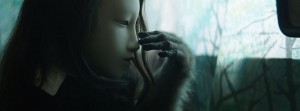LACMA exhibit explores odd world of Pierre Huyghe
The general public might not know him yet, but by the end of Pierre Huyghe’s show at the Los Angeles County Museum of Art, his name will be on everyone’s lips. Paris-native Huyghe has been on the contemporary art scene for a while, but this is his first retrospective in the United States and his first show in Los Angeles. This exhibit, at LACMA from Nov. 23 to Feb. 22, makes little tweaks and follows his retrospectives in the Centre Georges Pompidou in Paris and the Museum Ludwig, Köln.

Strange days · One of the many bizarre exhibits on display at the LACMA’s impressive Pierre Huyghe restrospective is the short film “Untitled (Human mask).” In the film, a monkey is dressed up as a young girl and it proceeds to play in different chambers in a series of irregular film loops. – Photo courtesy of LACMA
A retrospective is a compilation showing the development of an artist’s work over a period of time that implies reflection on a past creation. This show, however, is anything but static. Using a diverse array of media, from film to music, Huyghe creates evolving art organisms. Jarrett Gregory, who curated the exhibit has said that Huyghe’s work “lives on beyond his supervision.”
When you enter the exhibit, a uniformed man will shout your name to a cold, jagged space. He lets it echo in the darkness, intermingling with the scent of “Paris, 1738” (2014). Beyond you, there is a murky tank of squirming seafood, a pair of golden shoes called “Singing in the Rain,” (1996) and a super-8mm Japanese video that awaits. Perhaps you will run into “Human” (2012), a white Ibizan hound with one shocking pink leg, or his compatriot, “Player” (2010), an actor dressed in a mask made of LED lights, evocative of another sculpture in the exhibition.
Like “Human,” the spectator is allowed to roam free. There is no introductory blurb and no specified path to take. Freed by a lack of knowledge, Huyghe requires his spectators to take an exhilarating leap of faith. Even though it’s Huyghe’s name on the exhibit, it’s the audience’s world. Though Huyghe doesn’t completely efface himself, he is conscious that his art exists apart from him, making exhibit ideal for collaboration and exploration.
Though large “Do Not Touch” signs often grace museum walls, giving visitors the notion that “art” has only one method of appreciation, this place has different rules. The audience is invited to touch and to change. In one instance, when spectators entered a large black room with a mysterious box of smoke and colorful lights, they stood there for 10 minutes before trying to approach the box. In the shadowy center of the exhibit, there is lighted pad on the ceiling. The lighting sequence is programmed to the weather conditions at Giverny from 1914 and 1918, when Monet painted the “Nymphéas,” and it overlooks a tank of “biotopes” from Monet’s Giverny gardens. There are switches for the audience to change the sequence of lights, however.
At the very back of the exhibition hall are glass windows that lead into the L.A. sunshine. Outside you will find artificial rain, snow and fog beside a sculpture with a beehive for a head. The bees are of a different breed than the ones used in the European retrospective explained the beekeepers, and as the bees adjust to their new home they will act differently. The head of the sculpture will also become larger as the bees build up.
One would have to spend hours, maybe even longer in this strange and different space to see everything. Videos such as Pierre Huyghe’s film “Untitled (Human mask),” featuring a monkey dressed as a little girl, play in the different chambers in indeterminate loops. What you see in these videos may appear in the flesh, such as “Human.” The submerged rocks, the aquariums and the beehive will grow, making the exhibit change at every moment. After the audience leaves, the bees will adapt to their new home, as will “Human.” Life goes on even when the spectators are not there, which may be Huyghe’s real message.

